
Grade: 5
Teacher: Moldazhanova A.M.
The theme of the lesson: Kate’s shopping.
The form of the lesson: Traditional
The aims of the lesson:
Educational- to give the definition for countable and uncountable nouns, using them with a, some, any; to enrich students’ vocabulary with the new words of the theme “food”; to revise there is/there are, Is there/ Are there…?+ short answers.
Developing- to develop reading, writing, speaking skills; to develop memory, thought, imagination, dialogue and monologue speech.
Up-bringing- to bring up the culture of communication, the interest in buying food, cooking; to respect tastes of other people.
The equipment of the lesson- An active board, CD, CD-player, pictures of food.
The procedure of the lesson
I Organizational moment
1. Greeting
Teacher: Good morning, class!
Class: Good morning, teacher!
T.: Sit down, please.
2. Speech drill
T.: How are you?
What is the date today?
What is the day today?
What is the weather like today?
Who is absent today?
3. Phonetic drill
Look and listen to the poem, repeat after me.
What vowel sound do you hear two times?
S1, S2,S3 etc.
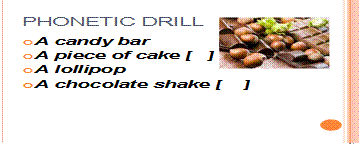
Look at the shopping list and then write the words in English.
Sandwich bread ham butter cheese pasta eggs etc.
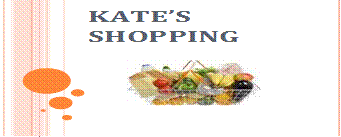
4. Setting the aims
T.: Today at the lesson we will talk about the food, we’ll go shopping for some delicious things; then we’ll make salads, and we’ll have the competition for the most disgusting recipe.
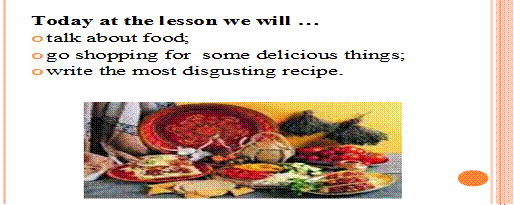
II The main part
1. Checking up the home work
T.: Your home task was to draw a picture of your dream home and describe it using “There is a … (for singular things)” and” There are some … (for plural things)”. So, you’re welcome!
S1, S2, S3, etc.
OK, thanks a lot!
2. Explanation of the new material
T.: Will you tell me: What does “countable noun” mean?
What does “uncountable noun” mean?

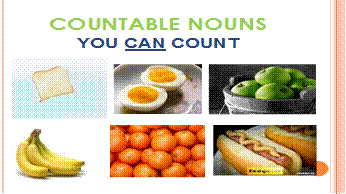
S3: It means- you can count them, but you can’t count uncountable nouns, for example: apples, eggs- count., sugar, water-uncount.
T.: OK, you’re right!
Countable nouns can be singular: a bottle an onion
and plural: some bottles some onions
Uncountable nouns are always singular, but we use some and any with them: There’s some water. There isn’t any bread. Is there any cheese?
We use ________ with uncountable nouns in affirmative sentences.
We use ________ with uncountable nouns in negative sentences and in questions.
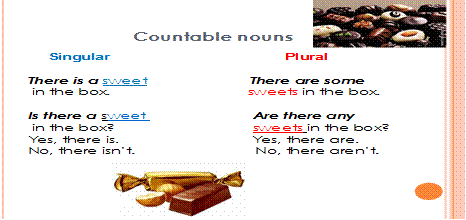
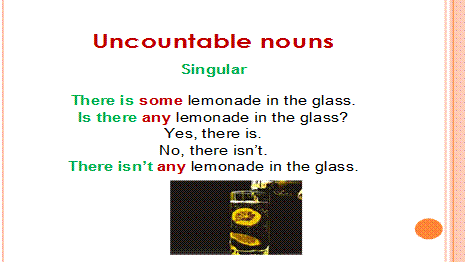
Now, we’ll go shopping to buy things we have in the shopping list. You should ask the shop assistant and he will answer you.
For example: Is there any bread?
No, there isn’t.
Are there any peppers?
Yes, there are.
One of you will be the shop assistant and will give the short answers.
Let’s start playing!
S1-S2, S3-S2, S4-S2, etc.
3. Practice
a) Exercise 6 a, b page 75;
b) Exercise 8 at page 75
“Disgusting recipe”
disgusting [ ]
recipe [ ]
Think of a disgusting recipe. For example: A milkshake with ice and onions.
An omelette with sardines and mushrooms.etc.
You’ll have three minutes to think of it. Then tell the class your idea. And who will tell the most disgusting recipe he will get the prize!

S1, S2, S3, etc.
III Concluding stage
1. Sum up
What was the theme of our lesson?
What did we do at the lesson?
What new have you learnt today at the lesson?
2. Giving marks
3. Giving the home task
To learn new words, work book p 41
4. Saying good bye
T.: Our lesson is over. Good bye, students!
Cl.: Good bye, teacher!
Материалы на данной страницы взяты из открытых источников либо размещены пользователем в соответствии с договором-офертой сайта. Вы можете сообщить о нарушении.